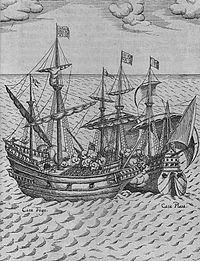- Spanish ship Nuestra Señora de la Concepción (1570)
-
The Spanish galleon Nuestra Señora de la Concepción (Our Lady of the (Immaculate) Conception) was a 120 ton vessel that sailed the Peru - Panama route during the 16th century. This ship has earned a place in maritime history not only by virtue of being Sir Francis Drake's most famous prize, but also because of her colorful nickname, Cagafuego.
Contents
Cacafuego Vs. Cagafuego
Despite her very proper name, the galleon Nuestra Señora de la Concepción was called by her sailors Cagafuego, which would translate into English as "fireshitter". Contemporary accounts presented the ship's name inaccurately as Cacafuego, which is the one that eventually endured. As it is, almost all references in English regarding this vessel list her name erroneously.
In Spanish, "caca" is a noun meaning "shit", while "caga" is the third person (or the second person accusative formal) of the verb "cagar" which means "to shit". Therefore, the proper nickname for this galleon was "Cagafuego," which could be translated as "shitfire" or more accurately as "fireshitter".
Capture by Sir Francis Drake
At the helm of his ship the Golden Hind, Sir Francis Drake had slipped into the Pacific Ocean via the strait of Magellan in 1578 without the knowledge of the Spanish authorities in South America. Privateers and pirates were common during the 16th century throughout the Spanish Main but were unheard of in the Pacific. Accordingly, the South American settlements were not prepared for the attack of "el Draque" (Spanish pronunciation of Sir Francis' last name), as Drake was to be known to his Spanish victims. During this trip, Drake pillaged El Callao (Peru's main port) and was able to gather information regarding the treasure ship Cagafuego, which was sailing towards Panama laden with silver and jewels.
Golden Hind caught up with Cagafuego on March 1, 1579, in the vicinity of Esmeraldas, Ecuador. Since it was the middle of the day and Drake did not want to arouse suspicions by reducing sails, he trailed some wine caskets behind the Golden Hind to slow her progress and allow enough time for night to fall. In the early evening, after disguising the Golden Hind as a merchantman, Drake finally came alongside his target and, when the Spanish captain San Juan de Antón refused to surrender, opened fire. The Golden Hind's first broadside took off the Cagafuego's mizzenmast. When the English sailors opened fire with muskets and crossbows, the Golden Hind came alongside with a boarding party. Since they were not expecting English ships to be in the Pacific, Cagafuego's crew was taken completely by surprise and surrendered quickly and without much resistance. Once in control of the galleon, Drake brought both ships to a secluded stretch of coastline and over the course of the next six days unloaded the treasure.
Drake was naturally pleased at his good luck in capturing the galleon and he showed it by dining with Cagafuego's officers and gentleman passengers. He offloaded his captives a short time later, and gave each one gifts appropriate to their rank, as well as a letter of safe conduct. Laden with the treasure from Cagafuego, Golden Hind sailed towards Plymouth, which he reached on September 26, 1580.
Disposition of its Treasure
There are few reliable accounts of the value of Cagafuego's holds. It is widely accepted that the ship was carrying a considerable amount of valuable items that were not reflected in her manifest. In addition, Queen Elizabeth forbade Drake of ever detailing the amount plundered, probably because she kept a large portion in excess of her share as an investor. In addition to this amount, there was a considerable amount of jewels and metals that were being transported "off the books".
A contemporary report describes, however, the contents of the Cacafuego included 13 chests of royals of plate, 80 lb gold, and 26 tons uncoined silver. The Spanish captain of the Cacafuego estimated the unregistered treasure at 400,000 pesos, which would be worth £12 million today.
Although we may never know the exact amount captured by Drake, we do know the following: Drake has stated that his backers received £47 for each pound invested, which is a 4,700% return even with the portion appropriated by the Queen.
References
- Cordingly, David. Under the Black Flag: The Romance and the Reality of Life Among the Pirates New York, Random House, 1995. ISBN 0-15-600549-2.
- Williams, Neville. The Sea Dogs: Privateers, Plunder and Piracy in the Elizabethan Age London, 1975.
Categories:- Age of Sail merchant ships of Spain
- 16th-century ships
Wikimedia Foundation. 2010.

